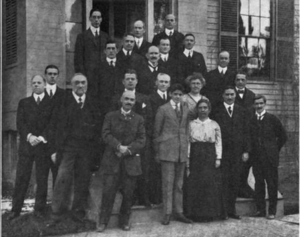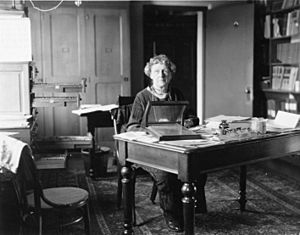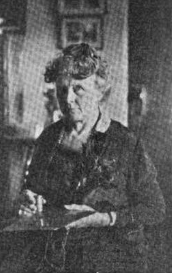Annie Jump Cannon facts for kids
Quick facts for kids
Annie Jump Cannon
|
|
|---|---|
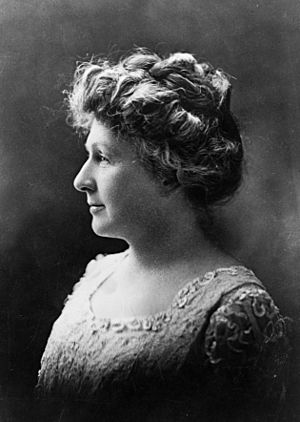
Cannon in 1922
|
|
| Born | December 11, 1863 Dover, Delaware, U.S.
|
| Died | April 13, 1941 (aged 77) Cambridge, Massachusetts, U.S.
|
| Alma mater | Wellesley College, Wilmington Conference Academy, Radcliffe College |
| Known for | Stellar classification |
| Awards | Henry Draper Medal (1931) |
| Scientific career | |
| Fields | Astronomy |
| Institutions | Harvard College Observatory |
| Influences | Sarah Frances Whiting, American physicist and astronomer |
| Influenced | Edward C. Pickering |
Annie Jump Cannon (December 11, 1863 – April 13, 1941) was an amazing American astronomer. She created a special way to organize and classify stars. This system is still used by scientists today!
Annie worked with Edward C. Pickering to develop the Harvard Classification Scheme. This was the first big effort to sort stars based on their heat and light types. Annie became almost completely deaf after 1893 because of scarlet fever. She was also a suffragist, meaning she supported women's right to vote. She was a member of the National Women's Party.
Contents
Annie's Early Life
Annie Jump Cannon was born on December 11, 1863, in Dover, Delaware. She was the oldest of three daughters. Her father, Wilson Cannon, was a shipbuilder and a state senator. Her mother, Mary Jump, was the first person to teach Annie about the stars.
Annie's mother encouraged her to follow her interests. She suggested Annie study math, chemistry, and biology. Annie and her mother would use an old astronomy textbook. They would identify stars from their attic. Her mother also taught her how to organize things. Annie later used these skills in her research.
Annie loved astronomy and followed her mother's advice. She lost most of her hearing when she was a young adult. Many people believe this was due to scarlet fever. Annie was known for her cheerful and lively personality. She chose not to get married or have children.
Annie's Education
Annie was a very smart student, especially in math. She attended Wilmington Conference Academy. This school is now known as Wesley College. In 1880, Annie went to Wellesley College in Massachusetts. This was one of the best schools for women in the U.S. There, she studied physics and astronomy.
Annie's teacher was Sarah Frances Whiting. Sarah was one of the few women physicists in the U.S. at that time. Annie became the top student in her class at Wellesley College. She earned her physics degree in 1884. After graduating, she returned home to Delaware for ten years.
During this time, Annie became very good at photography. In 1892, she traveled through Europe. She took many photos with her Blair box camera. When she came home, her writings and photos from Spain were published. They appeared in a pamphlet called "In the Footsteps of Columbus." This pamphlet was given out as a souvenir at the Chicago World's Columbian Exposition in 1893.
Soon after, Annie got scarlet fever. This illness caused her to become almost completely deaf. Her hearing loss made it hard for her to socialize. So, she spent even more time on her work. In 1894, Annie's mother passed away. Life at home became more difficult.
Annie wrote to her old teacher, Professor Sarah Frances Whiting. She asked if there were any job openings. Professor Whiting hired her as a junior physics teacher. This job allowed Annie to take advanced courses. She studied physics and astronomy at Wellesley College. Professor Whiting also inspired Annie to learn about spectroscopy. This is the study of light.
To use a better telescope, Annie enrolled at Radcliffe College in 1894. She was a "special student" and continued her astronomy studies. Radcliffe College was near Harvard College. Harvard professors would repeat their lectures for the Radcliffe women. This gave Annie access to the Harvard College Observatory. In 1896, Edward C. Pickering hired her as his assistant at the Observatory. Annie finished her studies in 1907. She received her master's degree from Wellesley College.
A Career Among the Stars
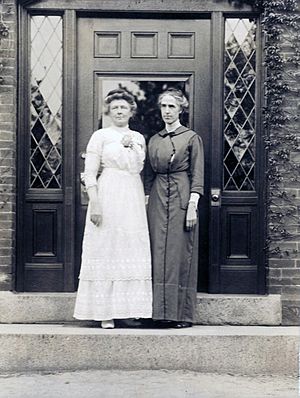
In 1896, Annie joined the Harvard Computers. This was a group of women hired by Harvard Observatory director Edward C. Pickering. Their job was to complete the Henry Draper Catalogue. The goal was to map and describe every star in the sky. They focused on stars visible up to a certain brightness. Annie called brightness "Int" in her notes.
In 1927, Pickering said Annie could classify stars very quickly. He said, "Miss Cannon is the only person in the world—man or woman—who can do this work so quickly." Mary Anna Draper funded this important work. She was the widow of a rich doctor and amateur astronomer, Henry Draper. Men at the observatory operated the telescopes. They took photographs of the stars. The women then examined the photos. They did math calculations and cataloged the stars during the day. Pickering made the Catalogue a long-term project. He wanted to get the light patterns of as many stars as possible. Then he would sort and classify them by these patterns.
When Annie first started, she classified 1,000 stars in three years. By 1913, she could classify 200 stars in an hour! Annie could sort three stars a minute. She did this just by looking at their light patterns. If she used a magnifying glass, she could classify even fainter stars. Her work was also very accurate.
Soon after the Draper Catalogue work began, there was a disagreement. People couldn't agree on how to classify the stars. Nettie Farrar started the analysis, but she left a few months later. Then, Antonia Maury wanted a very complex system. Williamina Fleming, who was in charge, wanted a simpler way. Annie found a solution. She started by looking at bright stars in the southern sky. She used a new system to divide stars into groups: O, B, A, F, G, K, M. Her system was based on how strong certain light lines were. Later, scientists understood these lines were related to star temperatures. Her system was then rearranged to match this new understanding.
In 1901, Annie published her first catalog of star light patterns.
Annie and the other women at the observatory faced criticism. People thought they were "out of their place" and should be housewives. Women usually didn't get high-level jobs in this field back then. Many were paid only 25 cents an hour. They worked seven hours a day, six days a week. Henrietta Swan Leavitt, another woman at the observatory, also made big discoveries. She, like Annie, was deaf. Annie became very good at her job. She was known for being neat and patient with the detailed work. She even helped the men at the observatory become more well-known. Annie helped set up partnerships and equipment sharing. She acted like an ambassador for astronomy around the world.
In 1911, she became the Curator of Astronomical Photographs at Harvard. In 1914, she was made an honorary member of the Royal Astronomical Society. In 1921, she was one of the first women to get an honorary doctorate from a European university. She received a degree in math and astronomy from Groningen University.
On May 9, 1922, the International Astronomical Union officially accepted Annie's star classification system. With only small changes, it is still used today! Also in 1922, Annie spent six months in Arequipa, Peru. She went there to photograph stars in the Southern hemisphere.
In 1925, she became the first woman to receive an honorary science doctorate from Oxford University.
In 1933, she represented professional women at the World's Fair in Chicago. In 1935, she created the Annie J. Cannon Prize. This award is for "the woman of any country, whose contributions to the science of astronomy are the most distinguished."
In 1938, she became the William C. Bond Astronomer at Harvard University.
The astronomer Cecilia Payne worked with Annie. Cecilia used Annie's data to show that stars are mostly made of hydrogen and helium.
Later Life and Legacy
Annie Jump Cannon worked in astronomy for over 40 years. She retired in 1940. Even after retiring, she kept working at the observatory. She worked until just a few weeks before she passed away. During her career, Annie helped women gain acceptance and respect in science. Her calm and hardworking nature earned her respect. She helped open doors for future women astronomers.
Annie Cannon died on April 13, 1941, in Cambridge, Massachusetts. She was 77 years old. She passed away in a hospital after being sick for over a month. The American Astronomical Society gives out the Annie Jump Cannon Award every year. It honors female astronomers for their excellent work.
Annie's Amazing Work
Annie Cannon classified more stars by hand than anyone else. She sorted about 350,000 stars in her lifetime! She also discovered 300 variable stars. These are stars whose brightness changes. She found five novas, which are sudden bright explosions on stars. She also found one spectroscopic binary, which is a pair of stars orbiting each other. She created a huge list of references, with about 200,000 entries.
Awards and Honors
Annie Jump Cannon received many awards and honors for her incredible work:
- 1921: She received an honorary doctorate from the University of Groningen in the Netherlands.
- 1925: She was the first woman to get an honorary doctorate from Oxford University.
- 1925: She was elected to the American Philosophical Society.
- 1929: The League of Women Voters chose her as one of the "greatest living American women."
- 1931: She was the first woman to receive the Henry Draper Medal.
- 1932: She won the Ellen Richards prize. This was from the Association to Aid Scientific Research by Woman.
- 1935: She received an honorary degree from Oglethorpe University.
- She was the first woman elected as an officer of the American Astronomical Society.
- The lunar crater Cannon is named after her.
- The asteroid 1120 Cannonia is named after her.
- People called her the "Census Taker of the Sky." This was because she classified 300,000 stars, more than anyone else!
- The Annie J. Cannon Award in Astronomy is named in her honor. It has been given out since 1934. Now it's given every year to a woman astronomer in North America.
- Cannon Hall, a dorm at the University of Delaware, is named after her.
- The Annie Jump Cannon House was the home of the President of Wesley College in Dover, Delaware.
- She was named Curator of Astronomical Photographs at Harvard.
- She was a member of the Royal Astronomical Society in Europe.
- She was an honorary member of Phi Beta Kappa at Wellesley College.
- She was a founding member of the Maria Mitchell Association.
- She is honored in Judy Chicago's art installation The Dinner Party.
- 1994: Annie Cannon was added to the National Women's Hall of Fame.
- In 2014, a Google Doodle honored her and her work.
- In 2019, she was featured on Delaware's American Innovation $1 Coin.
See Also
 In Spanish: Annie Jump Cannon para niños
In Spanish: Annie Jump Cannon para niños
- Harvard Computers
- Henry Draper Catalogue
- "Sisters of the Sun", eighth episode of Cosmos: A Spacetime Odyssey, 2014 American science documentary television series


